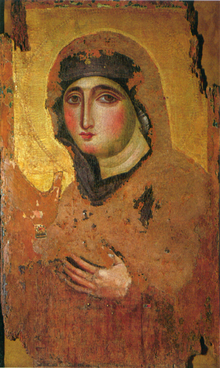
Back Maria Afrikaans Maria (Mutter Jesu) ALS ማርያም Amharic Santa María AN مريم العذراء Arabic ܡܪܝܡ (ܐܡܗ ܕܝܫܘܥ) ARC العدرا مريم ARZ María (madre de Xesús) AST Kitcitwa Marie ATJ Məryəm Azerbaijani
Mary | |
|---|---|
 | |
| Born | c. 18 BC[a] |
| Died | After c. 33 AD |
| Spouse | Joseph |
| Children | Jesus |
| Parent(s) | Joachim and Anne (according to some apocryphal writings) |
Mary[b] was a first-century Jewish woman of Nazareth,[6] the wife of Joseph and the mother of Jesus. She is an important figure of Christianity, venerated under various titles such as virgin or queen, many of them mentioned in the Litany of Loreto. The Eastern and Oriental Orthodox, Catholic, Anglican, Methodist, and Lutheran churches believe that Mary, as mother of Jesus, is the Mother of God. The Church of the East historically regarded her as Christotokos, a term still used in Assyrian Church of the East liturgy.[7] Other Protestant views on Mary vary, with some holding her to have lesser status. She has the highest position in Islam among all women and is mentioned numerous times in the Quran, including in a chapter named after her.[8][9][10] She is also revered in the Baháʼí Faith and the Druze Faith.[11]
The synoptic Gospels name Mary as the mother of Jesus. The gospels of Matthew and Luke describe Mary as a virgin[c] who was chosen by God to conceive Jesus through the Holy Spirit. After giving birth to Jesus in Bethlehem, she and her husband Joseph raised him in the city of Nazareth in Galilee, and she was in Jerusalem at his crucifixion and with the apostles after his ascension. Although her later life is not accounted in the Bible, Roman Catholic, Eastern Orthodox, and some Protestant traditions believe that her body was raised into heaven at the end of her earthly life, which is known in Western Christianity as the Assumption of Mary and in Eastern Christianity as the Dormition of the Mother of God.
Mary has been venerated since early Christianity,[15][16] and is often considered to be the holiest and greatest saint. There is a certain diversity in the Mariology and devotional practices of major Christian traditions. The Catholic Church holds distinctive Marian dogmas, namely her Immaculate Conception and her bodily Assumption into heaven.[17] Many Protestants hold less exalted views of Mary's role, often based on a perceived lack of biblical support for many traditional Christian dogmas pertaining to her.[18]
The multiple forms of Marian devotions include various prayers and hymns, the celebration of several Marian feast days in liturgy, the veneration of images and relics, the construction of churches dedicated to her and pilgrimages to Marian shrines. Many Marian apparitions and miracles attributed to her intercession have been reported by believers over the centuries. She has been a traditional subject in arts, notably in Byzantine art, medieval art and Renaissance art.
- ^ Cite error: The named reference
NewAdventwas invoked but never defined (see the help page). - ^ Meier, John P. (1991). A Marginal Jew: The Roots of the Problem and the Person. Yale University Press. p. 407. ISBN 978-0-300-14018-7.
- ^ Sanders, E. P. (1993). The Historical Figure of Jesus. Allen Lane Penguin Press. pp. 10–11. ISBN 978-0-14-192822-7. Archived from the original on 18 April 2017. Retrieved 1 September 2022.
- ^ "Catholic Enncyclopedia: Tomb of the Blessed Virgin Mary". New Advent. Retrieved 2 January 2023.
- ^ "Tomb of Mary: Location and Significance: University of Dayton, Ohio". udayton.edu. Retrieved 2 January 2023.
- ^ Brown, Raymond Edward; Fitzmyer, Joseph A.; Donfried, Karl Paul (1978). Mary in the New Testament. NJ: Paulist Press. p. 140. ISBN 978-0809121687. Archived from the original on 17 August 2021. Retrieved 23 February 2021.
...consonant with Mary's Jewish background
- ^ "Liturgy of the Assyrian Church of the East".
- ^ Quran 3:42; cited in Stowasser, Barbara Freyer, "Mary", in: Encyclopaedia of the Qurʾān, General Editor: Jane Dammen McAuliffe, Georgetown University, Washington DC.
- ^ J. D. McAuliffe, Chosen of all women.
- ^ Jestice, Phyllis G. Holy people of the world: a cross-cultural encyclopedia, Volume 3. 2004, ISBN 1-57607-355-6, p. 558 Sayyidana Maryam. Archived 27 July 2020 at the Wayback Machine.
- ^ Cite error: The named reference
Glenn2012was invoked but never defined (see the help page). - ^ Matthew 1:23
- ^ Isaiah 7:14
- ^ Bauercc/(Arndt)/Gingrich/Danker, A Greek-English Lexicon of the New Testament and Other Early Christian Literature, 2nd ed., University of Chicago Press, 1979, p. 627.
- ^ Mark Miravalle, Raymond L. Burke; (2008). Mariology: A Guide for Priests, Deacons, Seminarians, and Consecrated Persons, ISBN 978-1-57918-355-4, p. 178.
- ^ Mary for evangelicals by Tim S. Perry, William J. Abraham 2006 ISBN 0-8308-2569-X p. 142
- ^ "Mary, the mother of Jesus." The New Dictionary of Cultural Literacy, Houghton Mifflin. Boston: Houghton Mifflin, 2002. Credo Reference. Web. 28 September 2010.
- ^ Cite error: The named reference
protestantencyclopediawas invoked but never defined (see the help page).
Cite error: There are <ref group=lower-alpha> tags or {{efn}} templates on this page, but the references will not show without a {{reflist|group=lower-alpha}} template or {{notelist}} template (see the help page).